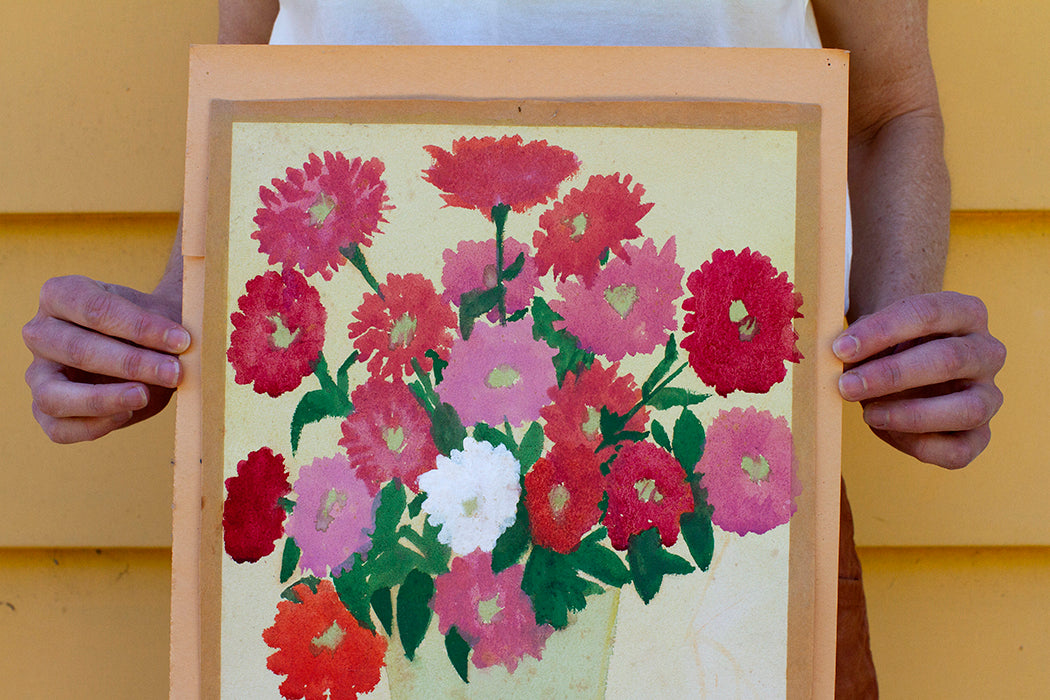
All Photos by Dustin A. Beatty
At Home with Ceramicist Rebekah Miles
Written and Photographed
by Dustin A. Beatty
Minutes after you exit highway 101 and head into the northern part of Ojai, ranchland on either side of the canyon envelopes you in terrestrial heaven. In between the grand oaks, avocado and cherimoya orchards, nasturtium flowers are ablaze under a blanket of green lilypad-like growth. Hummingbirds dart from one flower to another on ancient aloe succulents and bees hum with a fervor around clusters of lilac signaling the first signs of spring.
To call the area idyllic is an understatement;
in fact, Eden would be more of an apt description.
It’s no wonder that the artist Rebekah Miles’ family chose to plant roots in this valley. They first arrived in the mid-1800's, from Northern France on her mother’s side and the UK on her father’s. At the time, there was a mass exodus to the West, where many escaped lost hopes and mothballed dreams to try their luck in mining or, like Miles’ great grandparents, bask in the sunshine on a farm. Just about everything grows here and they found quick success in everything from lima beans to lemons.
“So many of my childhood memories were of me running around these ranches and our neighbor’s ranches,” Miles says, brightening up at the thought of the hours spent on making things with mud and plants.

The hours of endless exploration being footloose and feral amongst the organic elements fostered imagination and channeled a creativity that she is proud to pass on to her three year old daughter, Inez.
Miles’ family inherited more than just the land from her grandmother, Rosemary Carton. The prolific painter also passed down her affinity for flowers and a creative process informed by the surrounding landscape. “She left painting behind when she had kids to focus on ranch work and raise a family, but I was always around her paintings growing up,” Miles says. “When I started painting, I was even more drawn to her work, thinking about her and how that’s repeating itself with me.”

Like her grandmother, Miles was educated at Scripps of the Claremont Colleges, which led to a niche passion to paint her own version of her favorite book covers. Instead of re-imagining the artwork on the front, she pulled reference from a page inside to adorn volumes of printed matter by her most revered artists. Around 2008, fashion designers Kate and Laura Mulleavy of Rodarte came across Miles’ books at a shop in LA’s Echo Park called Show Pony and, intrigued, began the search for the source of these enigmatic renderings.
intrigued,
Rodarte began to search for the source
of these enigmatic renderings.
“I was at an art show at the Geffen museum when the phone rang,” Miles recalls. “They were on the other line saying, ‘We’ve been trying to track you down!’” That friendship led to collaborative exhibitions at NYC’s Opening Ceremony and Paris’ Colette, both in 2009. MOCA in Los Angeles then picked up the books that still sit to this day abreast Peter Shire sculptures and a Kara Walker pitcher, quickly canonizing Miles in conversation with artists she reveres.

Her work and their gentle surroundings
seemingly coexist together
Around that time, Miles was drawn to ceramics. “I had a similar feeling with the book covers, in that I was making these functional paintings—objects that were in between sculptures and paintings,” she adds. The work itself is sometimes playful, depicting a frog leaping head first into a puddle. Other pieces are nostalgic, like a relic one might find at an ancient dig in Greece or Egypt. To further that sense of nostalgia, each plate, platter, vase, or serving bowl is hand-made, sometimes referencing pieces from her grandmother’s collection. “Contemporary heirlooms” is how Miles describes them, with each shape and painting unique in not only telling her story but also carrying on her family’s tradition.
It makes sense that she cites Georgia O’Keeffe’s Ghost Ranch isolation as an inspiration. Miles' practice is articulated in a small pine studio with a cantilevered roof next to her clapboard cabin.

Just walking up to the studio is a meditative practice, as you pass by gooseberries that have self-seeded over the seasons or other edible varieties that have taken root from the daily spoils in the compost pile.
Miles also cites the bold and brave nature of Yoko Ono as an artistic inspiration,
whose sense of grace she admires. It’s something we can admire in Miles, too. There is an implicit grace in her delicate approach to self-care, her work and even the way she speaks.







